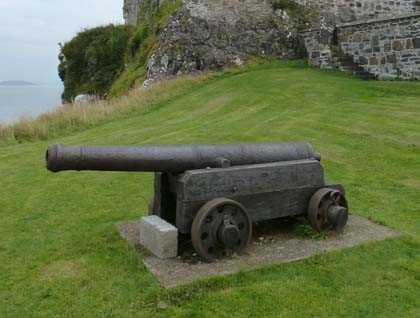We experienced some classic Scottish weather today: we started with a growthie (warm mist), then a dribble (drizzle), then it went plowtery (showery), by mid-afternoon we had a dreep (steady light rain) but by evening it was lown and lunkie (calm and sultry). Undeterred, we set sail from Tobermory (the Well of Mary), the safe, sheltered anchorage in the northeast corner of Mull, and steamed south down the Sound of Mull until we could dock at the ferry terminal at Craignure (Crag of the Yew).
Our morning’s destination was the spectacular Duart Castle, ancestral home of the Chief of the Clan Maclean. Set on black bluff overlooking the junction of three sea-lochs (hence the name Duart (Du-aird: the dark headland) it dominates the coastline for miles around. Once out of our coach, the castle towered above us, with a dizzying drop to the shoreline below. We toured the dungeons, the kitchens, past displays of medals won in campaigns across the globe, even candlesticks made of the hooves of one of the horses which survived the Charge of the Light Brigade. Each room was packed with dirks, claymores, memorabilia and the ancestral portraits from generations of Macleans.
In the afternoon we set out for a more spiritual experience: the remote religious retreat of Iona, a tiny island off the southwest corner of Mull which became a crucible of Christianity fifteen centuries ago. Our route took us up through conifer plantations on the eastern slopes, over the central mountains of Mull and down to the long fjord of Loch Scridain. As we passed one of the bare cliffs, we had superb views of a young golden eagle soaring slowly in wide circles. Our local driver, Steve, threaded his way round hairpin bends, over cattle grids, along narrow single-track causeways and over tiny stone bridges, all the while giving us a fascinating commentary on the history, humanity and hysterics of coping with tourist traffic on this rustic road: “I find that if you anticipate spectacular stupidity from any of the oncoming vehicles, you will seldom be disappointed…”
We made it in time for the ferry across to Iona, and then made our own pilgrimage inland past red granite cottage, by the ruined 13th century monastery and out past the tiny St. Oran’s Chapel to the glory of Iona Abbey. The site of this restored Benedictine monastery celebrates the piety of St. Columba, an Irish exile who arrived here in 563 AD. His teachings inspired generations of monks to carry the faith east into mainland Scotland and ultimately initiate great monasteries right across Europe, in France, Germany and Switzerland. This legacy still thrives on the island, for the multi-faith community which is based here today still has links with peace and poverty campaigns across the world.
There was much to ponder as we returned from this remote corner of Scotland: “a place in the middle of nowhere, at the centre of everything.” During dinner we rounded the southern tip of Lismore Island and within an hour were tied up at the dock in Oban, the main ferry port for the Inner Hebrides. Our vivid day was rounded off with a brilliant concert of Scottish folk music and song by the local band Peat Reek (“peat smoke”), their trio dazzling us with lively songs played on guitar, fiddle, squeezebox, bodhran (drum) and clàrsach (Scots harp).







